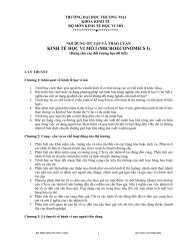The Internationalisation of PTT Telecom: A Cultural Perspective - Free
The Internationalisation of PTT Telecom: A Cultural Perspective - Free
The Internationalisation of PTT Telecom: A Cultural Perspective - Free
- No tags were found...
Create successful ePaper yourself
Turn your PDF publications into a flip-book with our unique Google optimized e-Paper software.
cultural strategies. Most literature lacks detailed information on cross-culturalmanagement as a result <strong>of</strong> expensive and time-consuming fieldwork and due tothe lack <strong>of</strong> access to execute fieldwork within the companies. Till now, little orno attention has been given to the cultural complexity <strong>of</strong> cross-culturalmanagement. Hannerz’ (1992) concept <strong>of</strong> cultural complexity focuses on thecomplex relation <strong>of</strong> three dimensions <strong>of</strong> contemporary culture; (1) ideas andmodes <strong>of</strong> thought, (2) forms <strong>of</strong> externalisation and (3) social distribution.Researchers <strong>of</strong> cross-cultural management give the most attention to the firstdimension, the shared values <strong>of</strong> people in a social unit (Hoecklin 1995, Lewis1996). This is surprising, because while globalisation processes may haveresulted in technical and economic integration, they have certainly not led tocultural integration or, to what might be called a global culture. <strong>The</strong> studies <strong>of</strong>Featherstone (1990), Hannerz (1992) and Friedman (1994) seem to show thatcontemporary culture has become more complex yet almost no detailed studieshave been conducted on the cultural complexity in cross-cultural managementthat provide a clear understanding <strong>of</strong> the ideas and modes <strong>of</strong> thoughts incorporations, the ways in which meanings are made public and the ways inwhich these cultural meanings are distributed. Research on cross-culturalcooperation in organisations therefore lacks a historical, processual andcontextual approach that is focused on actors (Bate 1997).A holistic anthropological approach is applied in this study to support theconnection <strong>of</strong> the restructuring <strong>of</strong> the telecom market, the history <strong>of</strong> the PTOand the change <strong>of</strong> organisational culture <strong>of</strong> the PTO with the daily life <strong>of</strong> PTOemployees. I support Mansell (1994: 40) who stressed the need to combine theanalysis <strong>of</strong> the social, cultural, political and economic constraints that shapeinstitutions in order to understand the process <strong>of</strong> globalisation <strong>of</strong> the PTOs.Behaviour <strong>of</strong> employees in organisations cannot be understood without ourknowing the context in which they are situated and cross-cultural managementcannot be studied separately from organisational cultures. <strong>The</strong> individualemployee plays an important role in the reproduction and renewal <strong>of</strong>organisational culture. Tennekes (1995) points at the dynamic character <strong>of</strong>culture, which cannot be separated from social action and therefore, is subjectedto permanent change. Galjart (1993: 8) also argues that reproduction and change<strong>of</strong> culture have to be at the interaction level. <strong>The</strong> question is not whether a newelement will be accepted but whether people can convince each other aboutwhat is right and what is wrong. In this way, employees try to establish theirposition within the organisation. Changes in the organisational culture dependon the power and position <strong>of</strong> the employees introducing them. <strong>The</strong> success <strong>of</strong>internationalisation therefore is strongly related to the change in organisationalculture <strong>of</strong> the PTOs.To obtain detailed information on cross-cultural cooperation the daily life inan organisation is studied. Even if detailed information has been presented oncultural complexity as was done by Deresky (1994) and Schneider and Barsoux(1997), it is still limited to a mosaic <strong>of</strong> small cases from a diversity <strong>of</strong>companies, industries and countries. Latour (1988, 1994 and 1997) studied thedaily world <strong>of</strong> scientists in laboratories, <strong>of</strong>fices and construction places. He3




